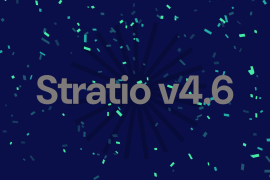In the evolving world of data management, two distinct approaches to data governance have emerged: declarative and actionable.
This article explores the differences between actionable and declarative data governance in alignment with the Data Management Association’s (DAMA) framework.
We’ll also explore the role of Stratio’s Generative AI Data Fabric in helping businesses transition from reactive to proactive data governance so they can more confidently adapt as their industry’s regulatory landscape evolves.
If you want to learn more about Stratio’s Generative AI Data Fabric and its capabilities for revolutionizing data management, read our latest whitepaper available in different languages. English , French and Spanish.
Actionable vs Declarative Data Governance
In the past, data governance often revolved around manual processes such as gathering information from isolated databases and spreadsheets, etc. This decentralized approach, commonly referred to as ‘declarative data governance,’ follows established guidelines, such as those outlined in the Data Management Association’s Data Management Body of Knowledge (DMBOK).
The main aim of declarative data governance is to create an accurate roadmap for managing data operations. It can change as a company grows, and its main focus is to create comprehensive data dictionaries that give data assets structure and context.
However, in highly regulated industries, such as healthcare and banking, the need to constantly update business glossaries can hinder a company’s ability to keep up with their compliance requirements as regulations evolve.
For example, it may become challenging for organizations to actively enforce and monitor the efficacy of their data and policies, as the company’s Chief Data Officer (CDO) must define and implement new data governance rules across multiple platforms (i.e., one for data security, another for metadata, architecture, data quality, and so on).
A decentralized data governance approach also requires that data quality checks are carried out at the end of the value chain, such as just before crucial reports are prepared. It does not give data quality measurements across end-to-end systems. Instead, it analyzes data quality at specific points, allowing errors and inconsistencies to be easily missed.
Actionable data governance, on the other hand, enhances a company’s ability to take a proactive approach by focusing on automation. It centralizes data management operations, removes information from silos, and establishes real-time management policies across departments, enabling businesses to quickly implement updates and resolve issues with data quality.
Shifting to actionable data governance through generative AI
Both declarative and actionable data governance strategies play a vital role. But for organizations to be effective in their data management practices, they must ensure complete visibility of all data systems.
Enter Stratio’s Generative AI Data Fabric – a first-of-its-kind data management solution that combines actionable and declarative frameworks with generative AI natural language processing. Our powerful tool puts data at the core of businesses, empowering organizations with data consistency and real-time insight to help them improve data governance and all other business processes.
Stratio’s five-step approach to actionable data governance
We take a customer-orientated, incremental approach to transforming an organization into an actionable data governance entity.
Here’s how Stratio delineates your actionable data governance journey in alignment with established data office guidelines and frameworks, such as DAMA:
1: Auto data discovery
First, we perform automated discovery of all data sources to generate a dynamic data catalog (or dictionary) that reflects the company’s metadata in real-time.
Unlike traditional declarative data governance, this phase reduces dependency on data officers to understand data structures. Instead, the automatically acquired metadata guides the subsequent processes and forms the foundation of the actionable data governance framework.
2. Semantic enrichment
Once the auto-data discovery stage is complete and we have created a metadata catalog of your company’s data sources in Stratio Governance, we enrich the data with semantic context. This creates a valuable data product that eliminates technical silos and unifies all virtualized data into a comprehensive map.
The semantic ontologies are industry and business-specific, creating cohesive and meaningful Business Views that can be used to effectively utilize all company data, regardless of your technology stack.
3. Collaborative development
We then create a comprehensive glossary of business terms in collaboration with your company’s data office.
Building data dictionaries (or glossaries) ensures all users have universal access to trusted term definitions. It also ensures that all metadata is traceable, aligned with your data governance protocols, and visible. This allows business users to access definitions and view lineages using Knowledge Graph capabilities. In turn, this stage enhances the shared understanding of data-governance concepts.
4. Quality rule integration
Stratio’s Generative AI Data Fabric safeguards the integrity of your data throughout its lifecycle. It embeds quality checks that ensure data integrity consistently across the data lifecycle.
At any point in the data lifecycle, companies can customize data quality rules to align with changing data quality frameworks. This will ensure that the different dimensions of data quality (completeness, accuracy, reasonability, integrity, uniqueness, etc.) are always met.
Our multi-engine generative AI model uses multiple agents, such as SQL, customer query understanding, moderative, and sequence agents, to generate more accurate and relevant responses than single-engine models like Microsoft Copilot. The agents work together to understand the user’s query, create a reply, and validate the answer before it is returned to the user. This helps to ensure that the responses are accurate and relevant, even for complex queries.
5. Data product generation
Leveraging Stratio’s Data Marketplace feature empowers businesses to create diverse data products, including reports, AI models, APIs, and more. These products are based on data that is governed by quality, semantics, and security. Data Contracts regulate access to the data products to ensure regulatory compliance.
Furthermore, the exposure of this knowledge through generative AI facilitates insightful interactions with semantic data assets through natural language, enabling intuitive decision-making.
Our holistic, five-step approach to facilitating actionable data governance empowers businesses to harness their data assets to move ahead of competitors.
How Stratio bridges the gap between declarative and actionable data governance
- Data modeling and design: Stratio aligns with DAMA’s focus on maintaining efficient data structures.
- Data storage and operations: We ensure the high availability and efficiency of data stores, including backups and restores of information.
- Data security: With security at the core of our solution, we provide granular access controls to help companies maintain complete data security at all times.
- Data integration: We facilitate seamless integration between systems, ensuring all information is traceable.
- Data governance: Our integrated approach helps companies set and enforce data quality rules and responsibilities.
Unlocking the full potential of data through Stratio Generative AI Data Fabric
Stratio’s Generative AI Data Fabric unites both actionable and declarative data governance approaches, utilizing DAMA’s strengths with easy access to fast and accurate data insights to drive strategic decision-making.
Learn more about Stratio´s Actionable Data Governance in our latest whitepaper. It is available in different languages. English , French and Spanish.




